Last Updated on June 16, 2025 by Aram Vardanyan
Do you love trying new things and are looking for the best Hawaiian fruits to try? We’ve got you covered!
This guide covers some of the top fruits in Hawaii – from popular ones like pineapple to lesser-known ones like sapote!

If we miss any of your favorite Hawaiian fruits, let us know in the comments. Thanks!
Best Hawaiian Fruits
Pineapple
When thinking about Hawaii’s fruits, one of the first that comes to mind is the sweet, juicy pineapple.
Even though pineapples are not a native fruit to Hawaii, they are originally from South America. Pineapples are Hawaii’s most popular fruit and are used in many Hawaiian foods.
The sweet white or yellow flesh inside the spiky skin grows on bushes. When ripe, field workers handpick the pineapples.
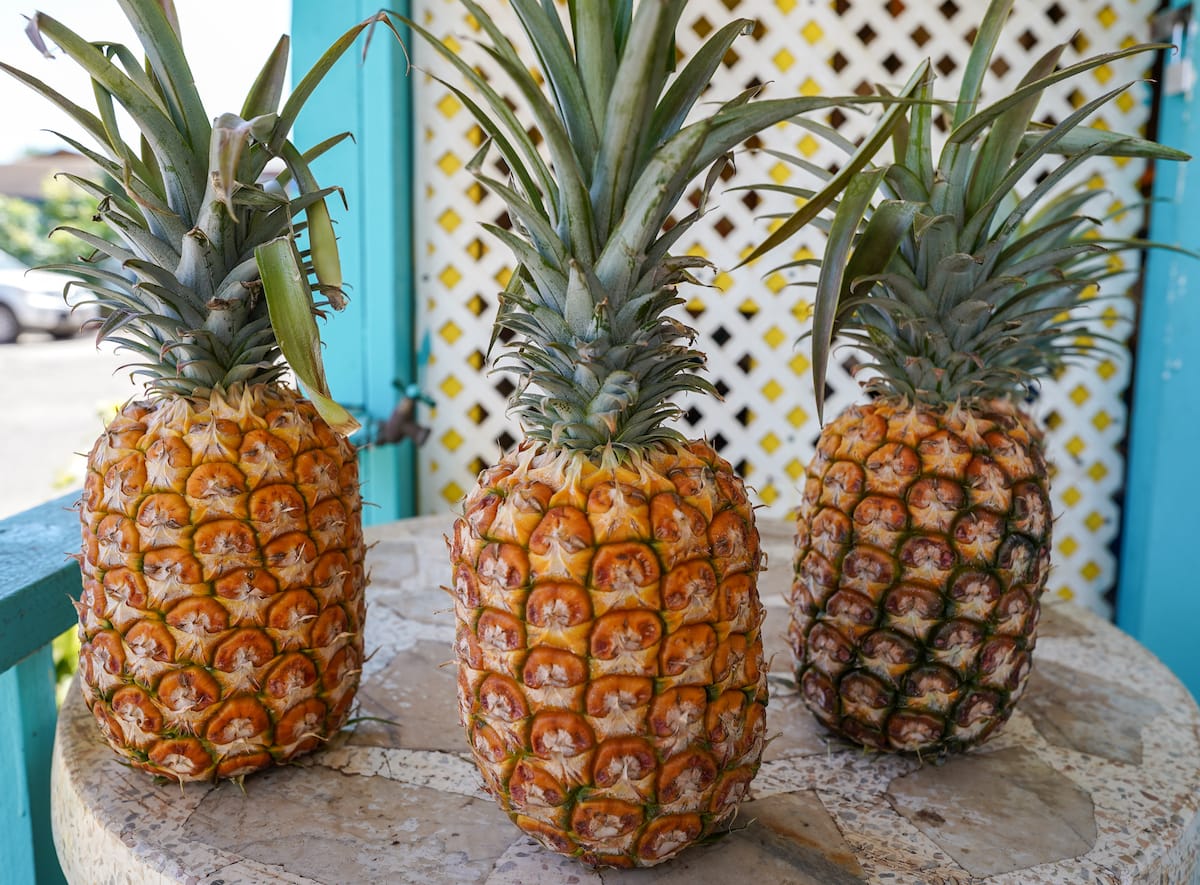
Pineapples are not quick-growing fruits. The first pineapple a plant produces takes between 18 and 20 months to grow, while the second fruit takes just over a year.
In the early 1900s, James Dole began Hawaii’s pineapple industry, and in 1922 he bought the island of Lanai to grow pineapples. In the 1960s, Hawaii grew more than 80% of the canned pineapples and was the biggest exporter of pineapples in the world.
Today, you will find small pineapple farms that are more for tourism than exporting pineapples. Maui Gold in Northern Maui, the Dole Plantation in Oahu, and Kauai Sugarloaf Pineapple offer tours.
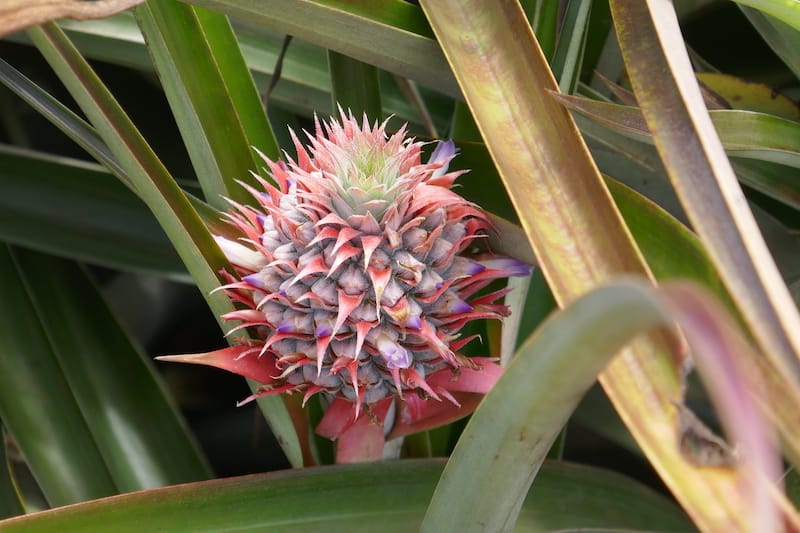
Besides eating fresh pineapple while in Hawaii, try the famous Dole Whip. This deliciously refreshing treat is soft-serve ice cream made with pineapple juice.
The best part of leaving Hawaii is taking a pineapple or two home as part of your carry-on luggage. The prime season for pineapple harvesting is from March through July.
Papaya
The papaya, the largest fruit that grows on a tree, is a well-known Hawaiian fruit (actually an herb) that originated in the Caribbean.
Since Christopher Columbus immensely enjoyed eating papayas, it is believed that the Spanish and Portuguese explorers brought papayas to Latin America, Mexico, and even Hawaii.
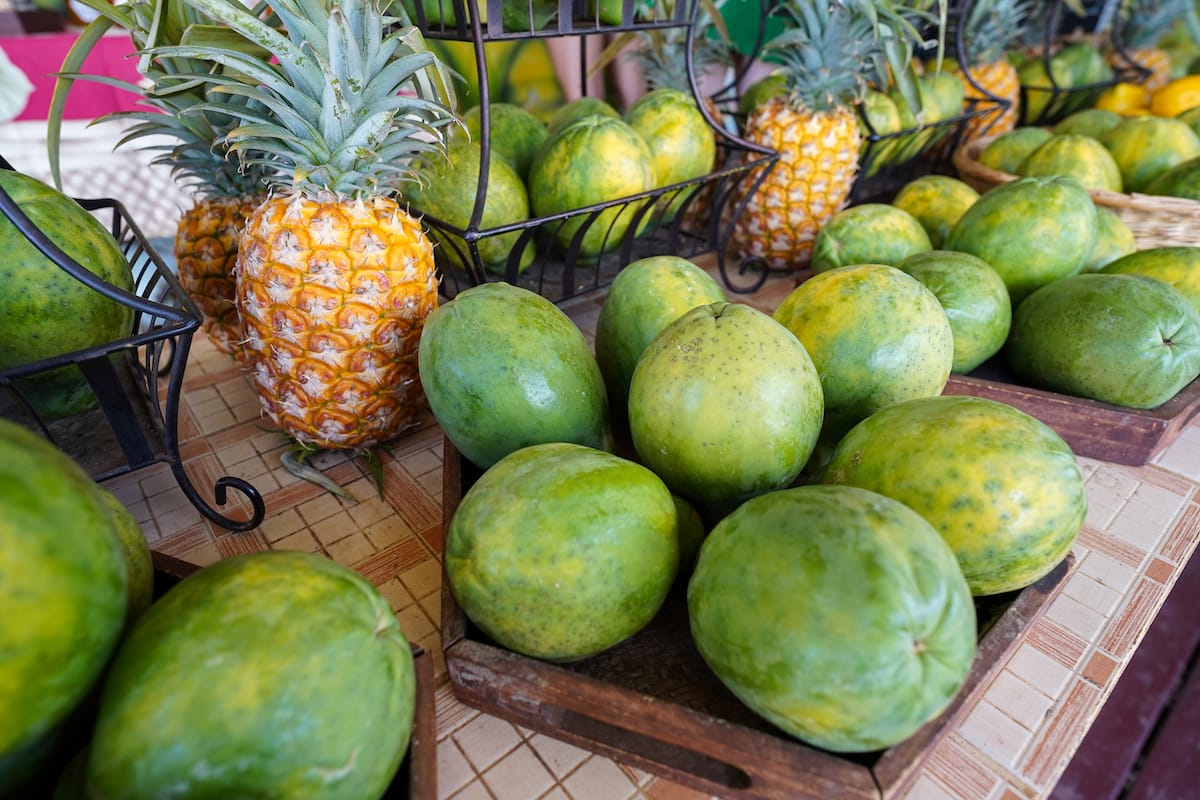
Today, you can find pear-shaped Hawaiian papayas growing on all the islands, but most of them grow on the Big Island of Hawaii.
The papaya tree may remind you of a coconut tree with green fruit hanging from the trunk.
Inside the papaya, you will find the dark yellow, pink, or reddish-orange pulp that is low in fat, a good fiber source, and rich in nutrients, making it one of Hawaii’s healthiest fruits to eat.
Even though papaya is known as the breakfast fruit, many people eat it after a large meal since it is believed to help with digestion.
The best way to eat papaya is to cut it open, clean out the black seeds like a cantaloupe or honeydew, and slice it up.
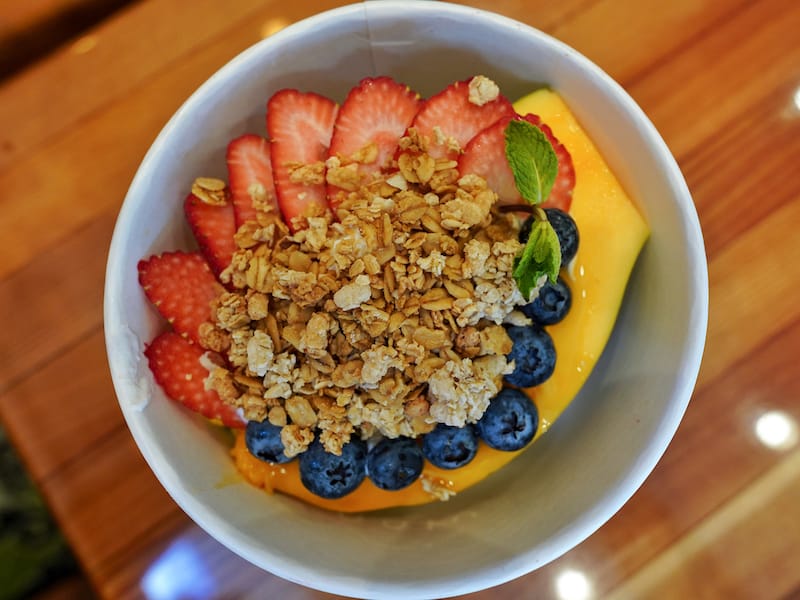
Many people like adding a spritz of lime juice to bring out more flavor. Besides just eating slices of papaya, chunk some up to add to your salad or make a delicious papaya smoothie.
However, as papayas ripen, the green fruit changes to almost all yellow and is a bit soft to the touch, so you know that it is ready to enjoy.
When on the Big Island of Hawaii, stop at the Kona or Hilo Farmers Markets for some of Hawaii’s freshest papayas. In Hawaii, you can enjoy fresh, ripe papayas throughout the spring and summer.
Mango
How could you go wrong with eating fresh mango slices, enjoying a mango margarita, putting mangos atop your chicken, in a salad, or topping on your shaved ice?
In the summer, when mangos are ripe, enjoy one of Hawaii’s sweetest fruits. On the islands, you can find more than 60 varieties of mangos, including Pirie, Rapoza, and the most common and commercially grown Haden.
The mango is native to South Asia and is believed to have been brought to Hawaii by Captain John Meek in 1824 as he traveled from Manila, Philippines.
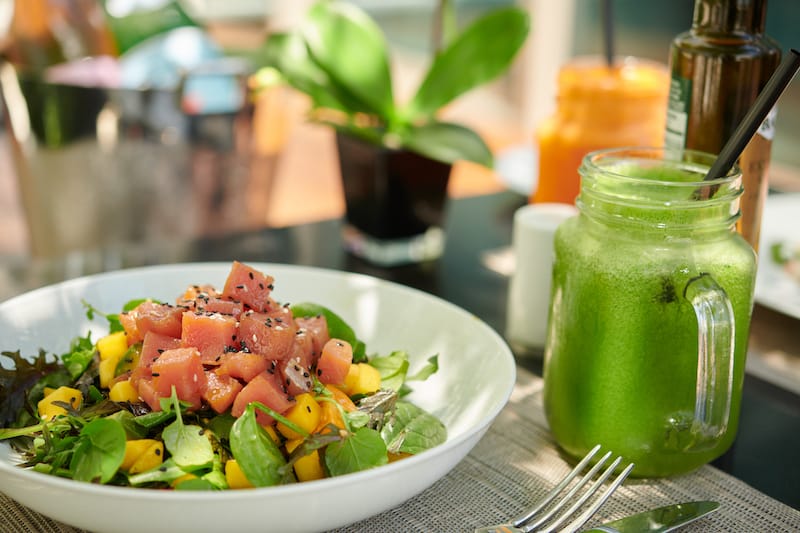
There are over 500 different kinds of mangos on the Hawaiian Islands. You’ll see tons of mango trees growing everywhere, including many in people’s front and backyards.
When the mango skin is a colorful red, yellow, orange, and green, you know it is ripe and ready for picking. This sweet and juicy fruit is delicious both at room temperature and chilled.
To eat a mango, enjoy it like you would eat an apple or cut it in half and then cut the meat of the mango in a checkerboard pattern and turn it inside out and eat the cubes.
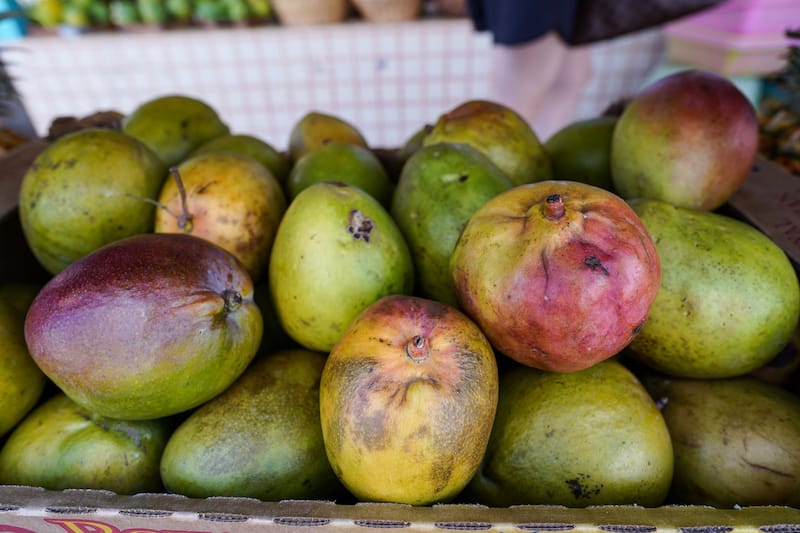
For a special treat, you should sprinkle some li hing mui powder (dried salted plum) on your mango before eating since the salt brings out the mango’s sweetness.
If you are not lodging at a location with a mango tree, head to a roadside fruit stand, where you will find a homegrown mango, not a commercially produced one.
Unlike the pineapple, it is illegal to bring mangoes from Hawaii to the mainland, so if you want to share Hawaii mangoes with friends back home, pick up some dried or pickled mangos to share.
Mangos in Hawaii are usually ripe from May through October.
Coconut
Even though coconuts may be challenging to eat due to their hard outer shell, a trip to Hawaii would only be complete with having some.
The early Polynesian settlers traveling to Hawaii brought coconut palms with them and found that the palms grew well in the rich volcanic soil.
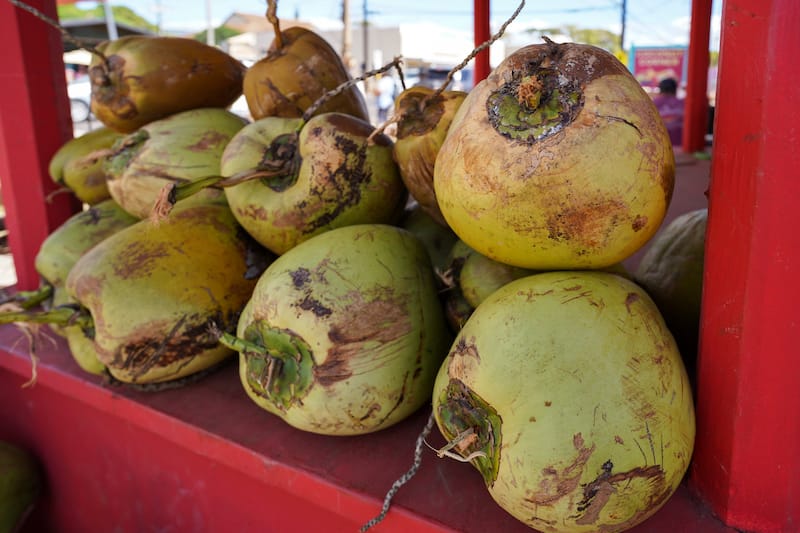
When coconuts are young, green, and not completely ripe, they are perfect for drinking coconut water to quench your thirst after surfing or hiking.
This is also a great time to eat coconut meat since if you get a mature brown coconut, the meat has a higher fat content.
While in Hawaii, if you have had the Haupia dessert often served at luaus, the main ingredient is coconut
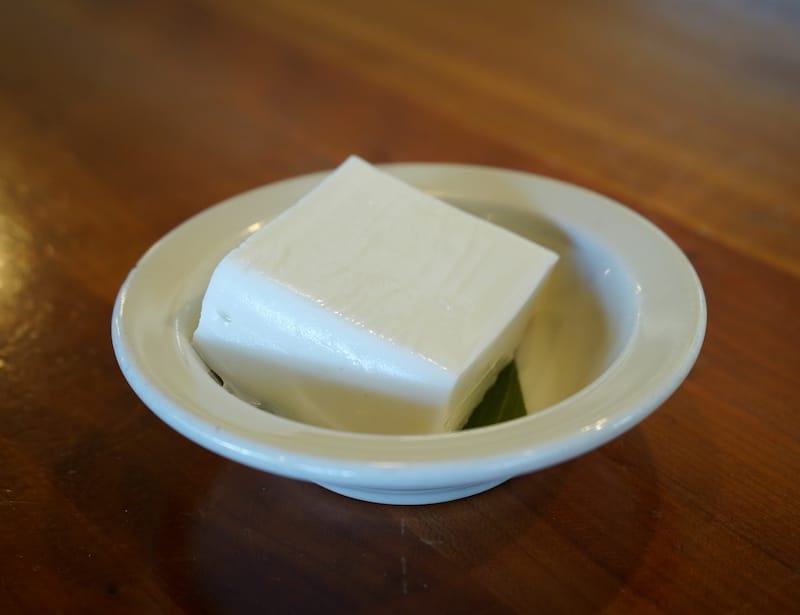
If you don’t want to go through all the work of cracking open a coconut, visit a Farmers Market and pick up some dried coconut, it is like eating candy!
When visiting Kauai, you will want to head to the large grove of coconut palms across from the Coconut Market. However, watch out for falling coconuts as you walk among the coconut trees!
Lilikoi (Passion Fruit)
The passion fruit, or lilikoi in Hawaiian, is a small, tart fruit. The outer skin is bumpy and either yellow or purple.
Cut the fruit in half, and you will find a light-yellow flesh with tiny, black eatable seeds. Even though the seeds are edible, they are very tart, and many people prefer to scoop them out and dispose of them instead of eating them.

Besides just eating passion fruit, they are excellent in fruit smoothies, acai bowls, a topping for ice cream, or in juice like POG juice.
Even though the passion fruit is not native to Hawaii but to Brazil and Argentina, you will want to try it while visiting Hawaii.
To take some home, purchase a jar of lilikoi jam or lilikoi tea which is excellent before bedtime since it contains Harmala alkaloids which make you sleepy.
Kumquat
The small, orange or yellow kumquats native to China now grow on trees in Hawaii.
Enjoy eating kumquats like you do grapes since the fruit’s skin is sweet, and it balances out the sour orange flesh inside. Just be sure to spit out those little seeds.
The kumquats are very healthy and are full of fiber and vitamin C.
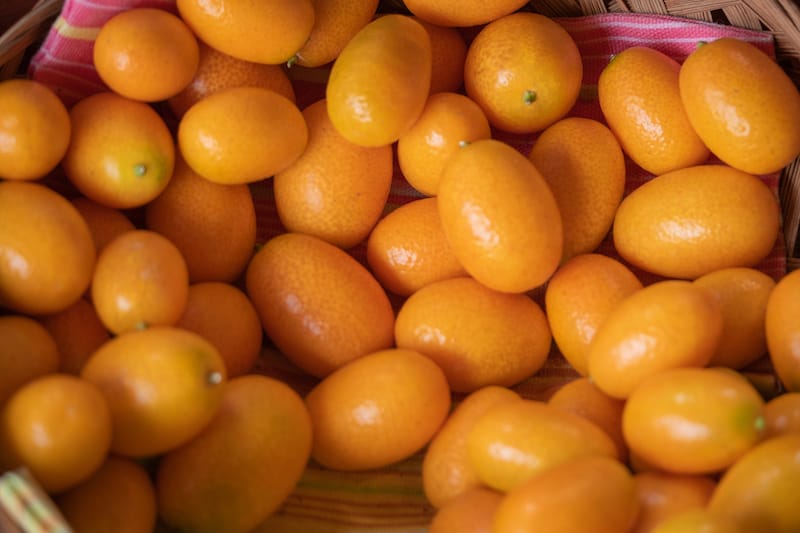
If you are in Honolulu, stop by the Aloha Stadium Swap Meet on a Wednesday, Saturday, or Sunday and check out the vendors that sell kumquat marmalade or sugared, candied, or dried kumquats.
The kumquats will be great to snack on during that long flight home. Kumquats are in season during the winter, from November through March.
Avocado
Even though avocados are technically classified as berries, many people consider them large fruits.
The avocado is native to Central America, Puerto Rico, and Mexico, and voyagers from those countries brought avocado seeds with them on their journey.
They planted the seeds in family gardens and their backyards.
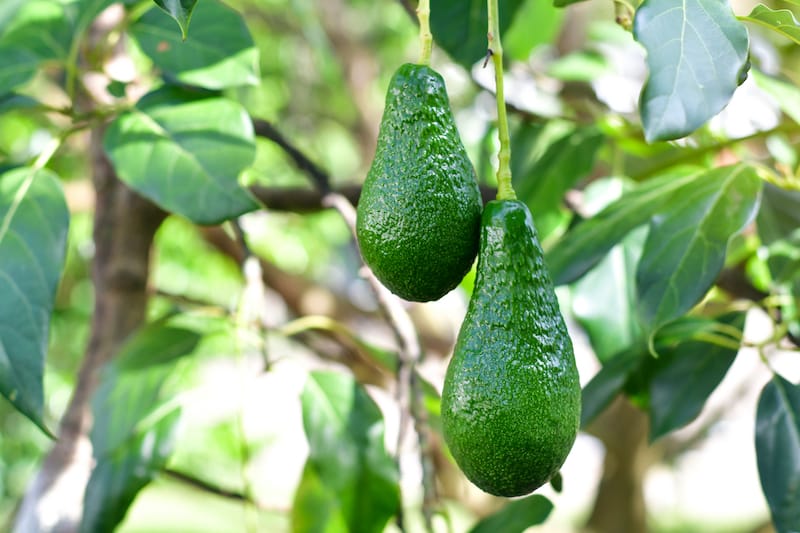
Typically, on the mainland, we buy Hass avocados. However, many of the avocado trees in Hawaii are of the Kahalu’u variety, which many Hawaiians feel has the best flavor.
Besides the Kahalu’u, there are more than 200 varieties of avocados grown in Hawaii, which include the tiny egg-sized Jan Boyce to the 11–14″ long Fukumitsu.
Avocados are ready to be picked between September and May, with the Kahalu’u variety ripe between August and November. However, avocados do not ripen on the tree; they ripen after picking.
So, head to a local farmers market or your Air-B&B’s backyard and pick up a fresh avocado or two.
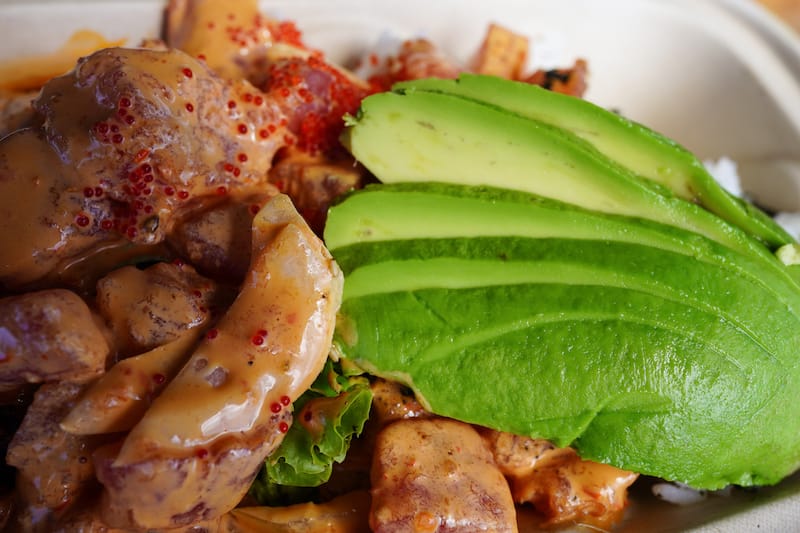
Once selected, you will know they are ready for that guacamole dip when they are a bit soft. Mashed avocado on sandwiches instead of mayonnaise is also a great healthy alternative.
Freshly picked avocados usually ripen at room temperature after four or five days.
Avocados are a very healthy fruit since they contain more than 20 vitamins and minerals and can suppress your appetite for hours with their high fiber content.
Persimmon
Persimmons are a fall fruit that remind you of a tomato with yellow-orange skin but grows on a tree. The persimmon is native to China and grows in Hawaii at elevations over 2,000 feet.
The most common place to find them is in Maui’s Kula District as you head to Haleakala National Park for sunrise or sunset.
Even though the persimmon may look like a tomato and are excellent in salads, they taste like a mango with honey and sweet peppers.
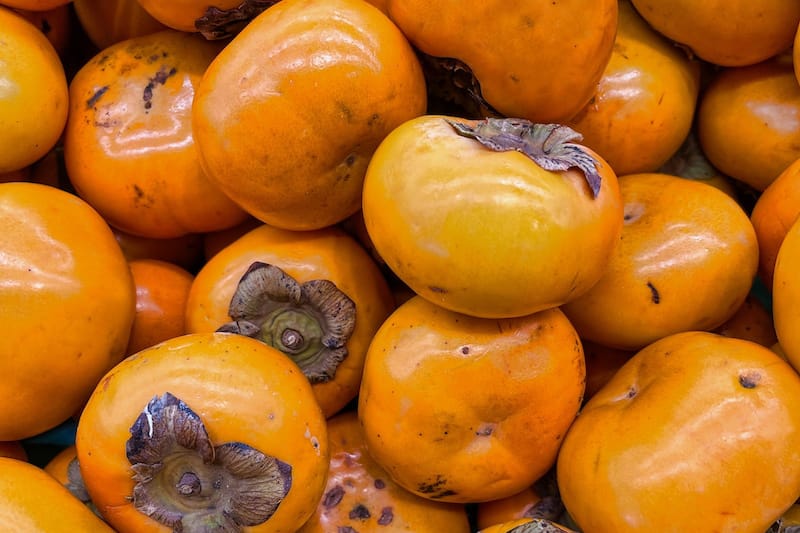
To eat a persimmon, you can eat it like an apple or dice it up into bite-sized pieces.
The persimmon fields are beautiful in March and April when they are in blossom, and they are ready to pick between October and early December.
If you have time, Hashimoto Persimmon Products in Kula offers tours of their farm and has a variety of persimmon products for purchase.
Strawberry Guava (Waiawi)
Since the early 1800s, when Brazilians brought strawberry guava to Hawaii as an ornamental tree, Hawaiians have enjoyed the sweet but tangy waiawi.
The small, red-skinned berry can be eaten like blueberries or blended into a strawberry guava smoothie or Passion-Orange-Guava juice, added to salads or made into sauces for chicken, jams, and jellies.
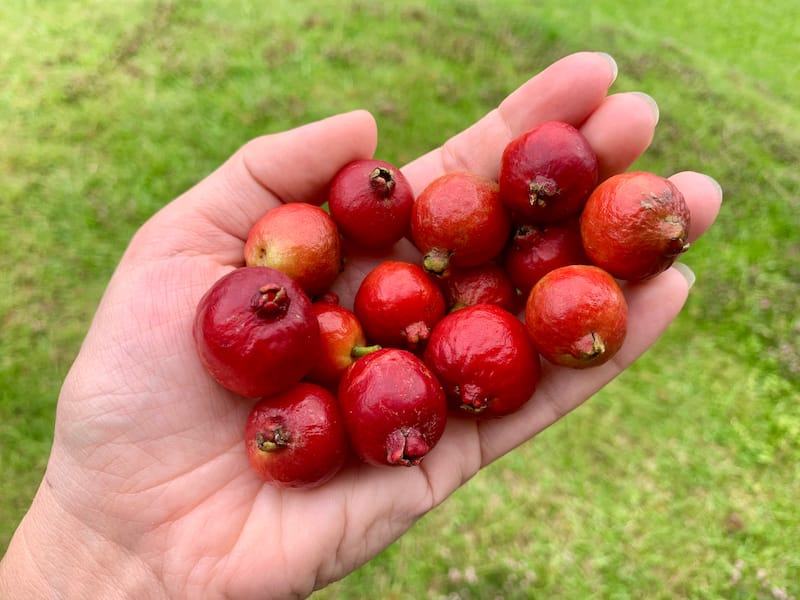
The guava’s flavor is a cross between a pear and a strawberry. You can eat the strawberry guava when they are ripe and dark red but also when they are still a bit green, and the berries that are a little green will be more tart.
As you hike throughout Hawaii, you will likely pass strawberry guava trees.
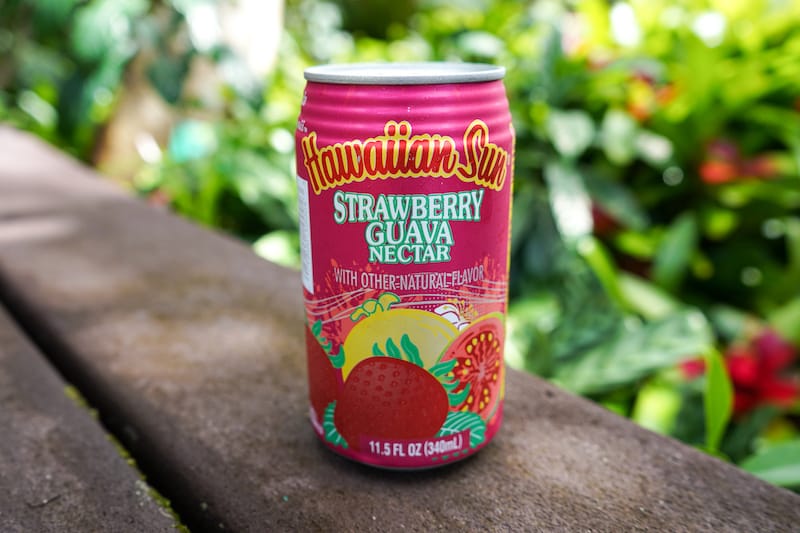
If you hike the Wiliwilinu Ridge Trail on Oahu, you will have stunning views and walk through a large strawberry guava forest near the bottom of the trail.
Be sure to bring a bag to pick a few as a snack for along your hike, or take them back to your Air B&B and make a breakfast smoothie.
Breadfruit (‘Ulu)
Originally from New Guinea, the starchy green breadfruit was a staple for many early explorers.
As the voyagers traveled to new lands, they often took a small sapling with them since one breadfruit tree can produce between 250 and 1,000 pounds of fruit each year, and the average life span of a tree is between 75 and 100 years. That, my friend, is a lot of breadfruit!
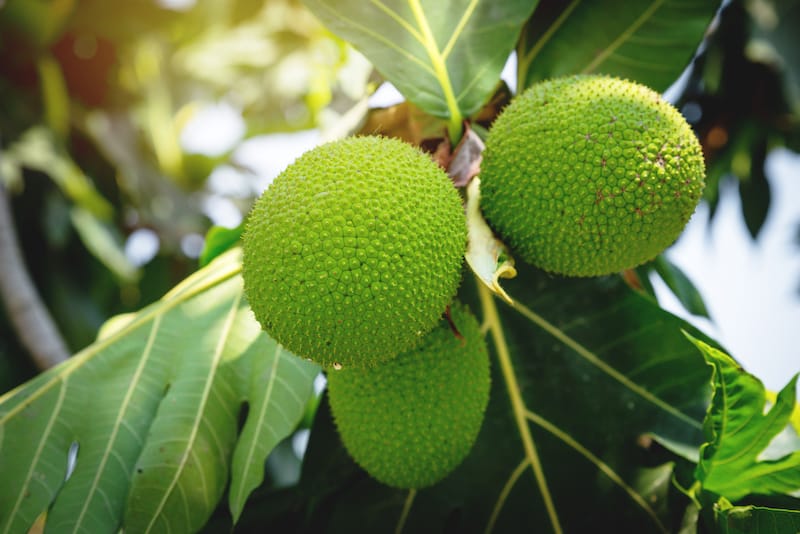
While the breadfruit could ward off starvation for the early Polynesian voyagers, they also used the wood to make lightweight outrigger canoes, while the sap was used as a glue or sealant.
Today breadfruit wood is also used to make drums and surfboards.
The breadfruit is quite large and, once ripe, weighs in at one to four pounds. Scales cover the brown and green skin. The inside is yellow or white and starchy with the texture of a potato.
It is high in carbohydrates and a variety of vitamins and minerals. Besides all that, it has no fat content and is naturally gluten-free.
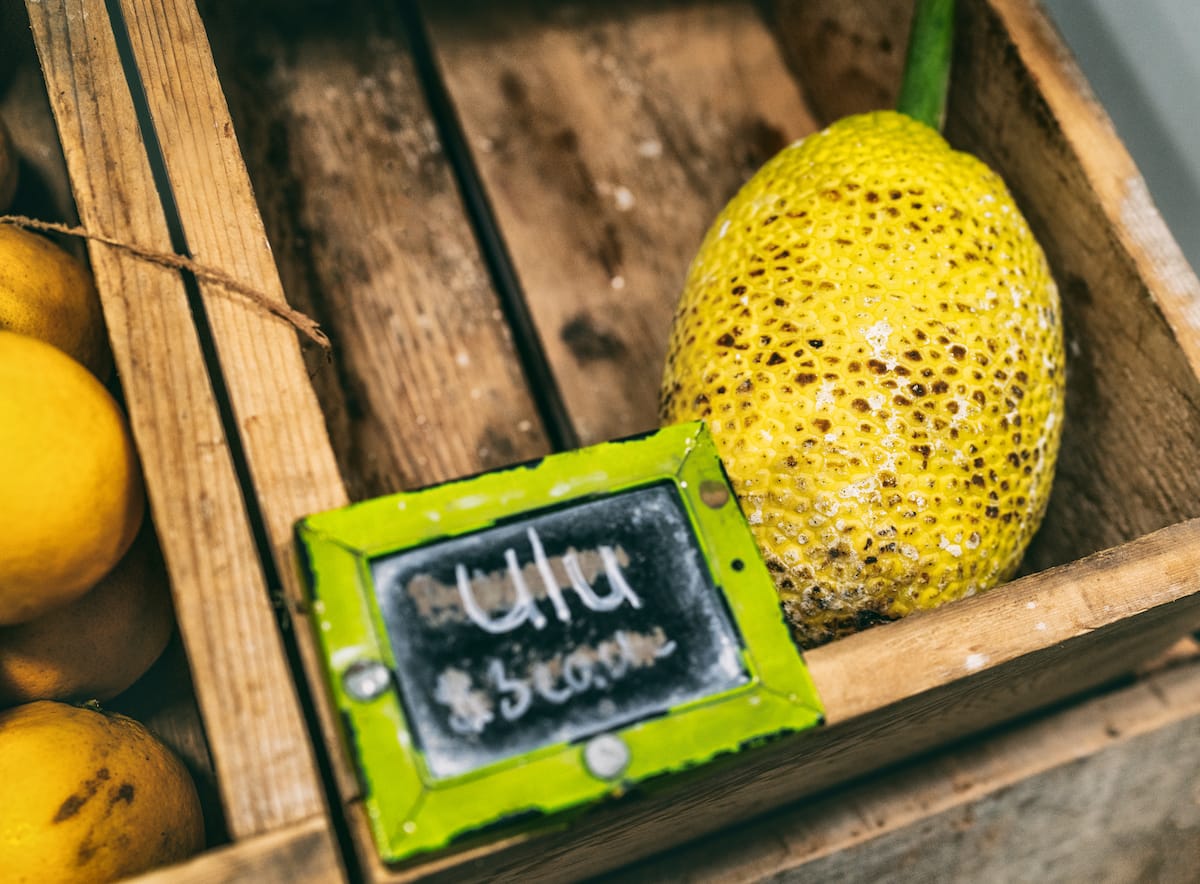
It can be eaten raw by cutting it in half and scooping out the flesh, but most people like it mashed and cooked with coconut milk or made into hummus.
If you are visiting Kauai, visit Allerton Gardens, where you can learn more about breadfruit.
Local Farmer’s Markets are great places to find breadfruit hummus to take home with you. Breadfruit is in season throughout the summer, from June through October.
Lychee
In 1873, Ching Chock came to Hawaii from China with the first lychee plant. Since then, the tiny bright red berry that looks similar to a raspberry has become a popular tree in Hawaii neighborhoods.
To eat the lychee, peel the skin off, remove the seed, and enjoy the sweet, white fruit with a consistency similar to a grape.
The lychee pairs perfectly with a glass of wine or mixed in a fresh fruit salad. Besides eating them raw, you may even find lychee jelly or lychee green tea at the local farmer’s markets.

Many people enjoy eating lychees since they are so healthy and are a great source of vitamin B-Complex and vitamin C, along with various antioxidants.
From May through September, the lychee berries in Hawaii are in season and ready to be picked.
Longan
The Asian longan fruit grows in clusters on trees and is similar to the lychee.
The small brown fruit is leathery on the outside, but the white fruit inside is chewy and sweet with just a splash of tartness.
To eat longans, you need to crack the outer skin, remove the seed and eat the fleshy fruit.
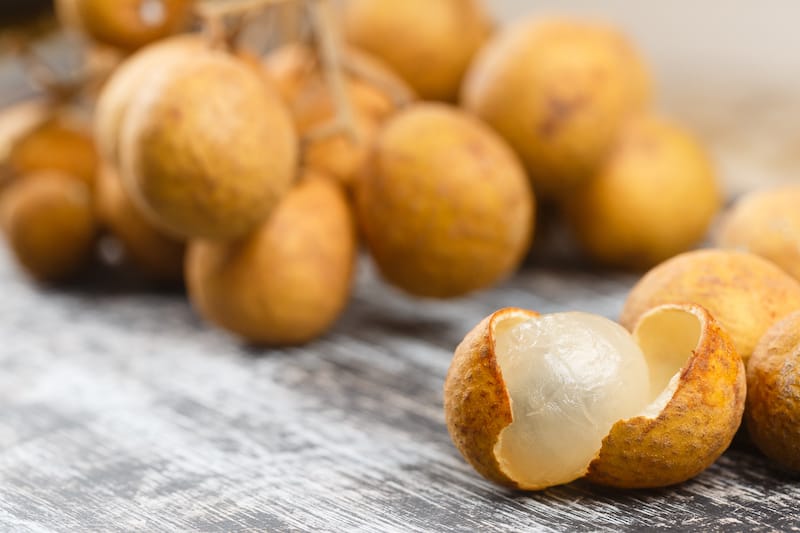
If you cut the fruit in half, you will see why the Chinese call the longan dragon’s eye since the dark seed in the middle of the white fruit looks like an eyeball staring at you.
Besides just eating longans, you may find them in salads, desserts, and sorbets. Longans are one of the fruits you can find year-round in Hawaii.
Egg Fruit
The egg fruit tree is native to El Salvador, Belize, and Guatemala and produces an oblong, bright yellow fruit around 3 to 4 inches long.
Egg fruit is either yellow or orange and is a drier fruit that might remind you of the consistency of the yolk of a hard-boiled egg.
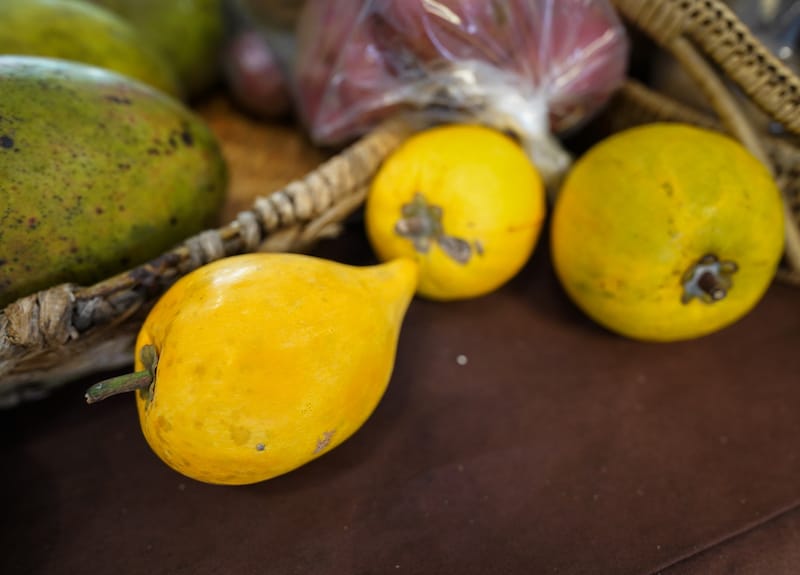
You can either sprinkle the egg fruit’s flesh with salt or lemon juice and eat it, crumble it up like a hard-boiled egg and add it to your salad, or spread it on toast.
The egg fruit is also a great cooking fruit and makes a terrific filling for stuffed mushrooms, thickener for soup, or added to a cheesecake. You can also add it to yogurt, milkshakes, eggnog, or juice.
Noni
Noni may not be the most popular or tastiest of Hawaii’s fruits. Still, Hawaiians use noni as a medicine for arthritis and as a painkiller or antibiotic.
It is even said that it is about ¾ as effective as morphine to lessen pain.
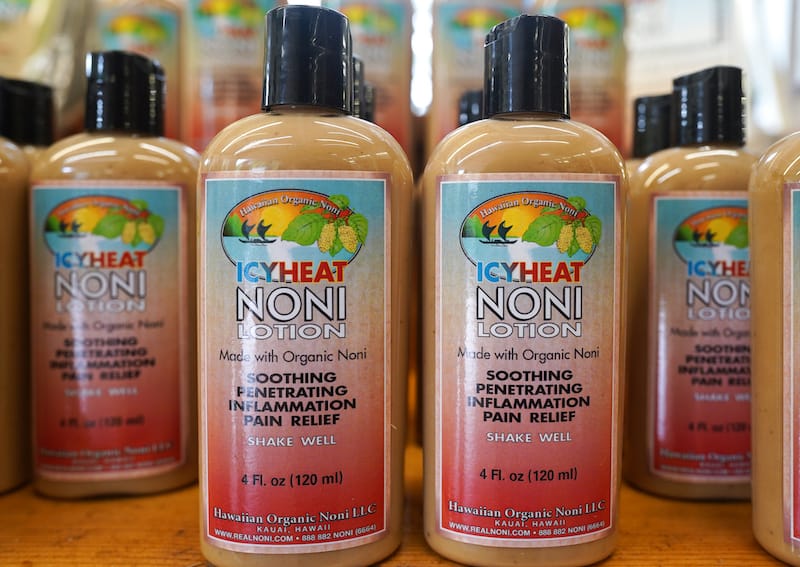
The green, leathery-looking, lemon-sized fruit tastes a little like blue cheese and is quite tart with a fishy aftertaste. Those who eat noni often blend it into juice or cut it up and add it to a salad.
The Real Noni Farm in Kilauea, Kaua’i, offers 2 ½ hour tours of their farm, where you will stroll the orchards, taste the fruit, learn more about the health benefits, and see the various products they produce from this strange-looking fruit.
Also, while on Kaua’i, you may want to take Captain Andy’s Rafting Expedition along the Na Pali coastline.
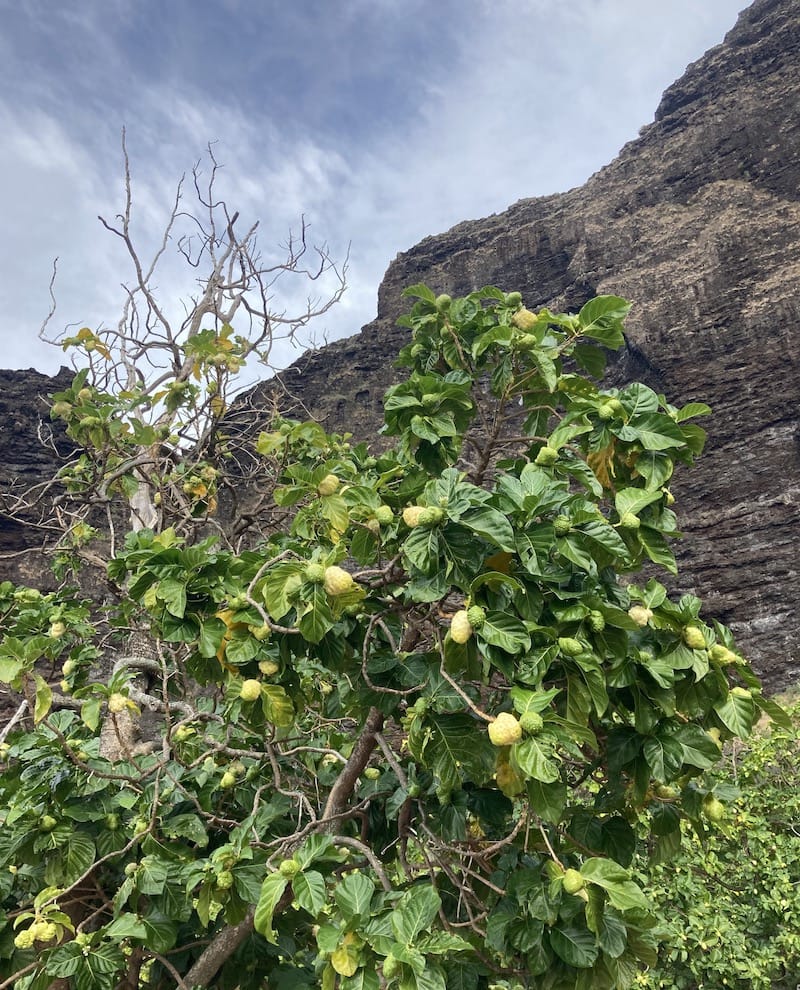
During the excursion, you will stop at the remote Nualolo Kai, where you will enjoy a meal and a hike through the ruins of the Hawaiian fishing village. Here you will also find types of noni that not even the birds will eat!
Soursop
Native to the countries in northern South America and across the Caribbean, the prickly green soursop fruit that can grow to about a foot long is the fruit of a soursop tree that can grow to around 30 feet tall.
The soursop fruit can weigh up to 15 pounds and is eaten by peeling it like a banana, then pulling off pieces of the white flesh like string cheese, or cutting the soursop in half and scooping out some of the meat.
Soursop is very flavorful and tastes a bit like a mixture of pineapple and mango with a bit of sourness.

Its flesh is an excellent addition to a blended fruit juice or mixed in your dish of ice cream. Besides being tasty, the soursop has a significant amount of Vitamin C.
In Hawaii, the soursop fruit is ripe and ready to be enjoyed between June and October.
Apple Banana
Hawaiian apple bananas are a local favorite and can make delicious banana bread. The bananas are much shorter, about half the length of the bananas we buy on the mainland.
They grow in large bunches and the banana peel changes from green to either yellow or pink peel when ripe.
These little bananas pack a robust, tangy flavor and are a great addition to a banana smoothie, sliced on your breakfast cereal or bowl of ice cream.
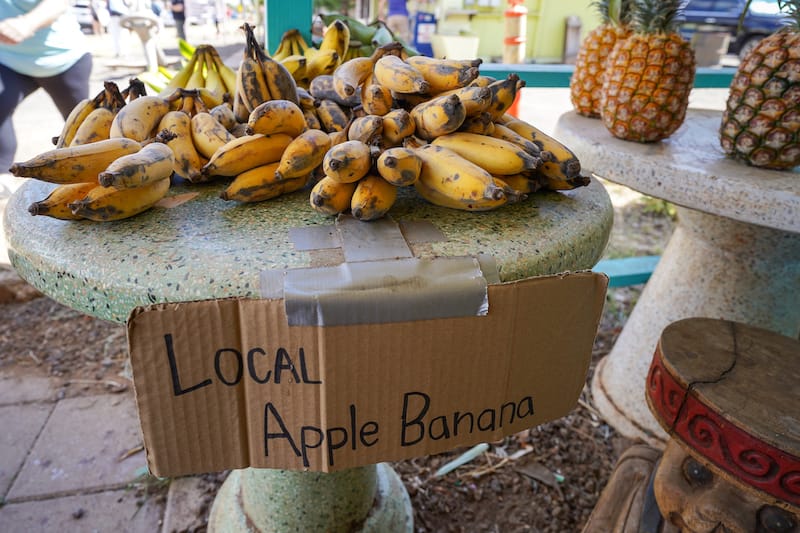
Apple bananas are easy to find across Hawaii at a farmers’ market, a roadside fruit stand, or the local grocery store. This is one of the Hawaiian fruits that are not shipped to the mainland.
If your travels take you down the road to Hana on Maui, stop at Twin Falls, Aunty Sandy’s, Halfway to Hana, or Hana Farms and try their fantastic banana bread. Then, on your way back, pick another one or two to try.
Try an apple banana if your travels take you to Hawaii between June and October. All you have to do is peel the peel back and enjoy.
Sapote
Sapote comes in various colors and is a native Central America and Eastern Mexico fruit related to the persimmon.
The white sapote tastes like eating a sweet potato custard with a dash of vanilla, and the black sapote tastes like a creamy chocolate pudding.
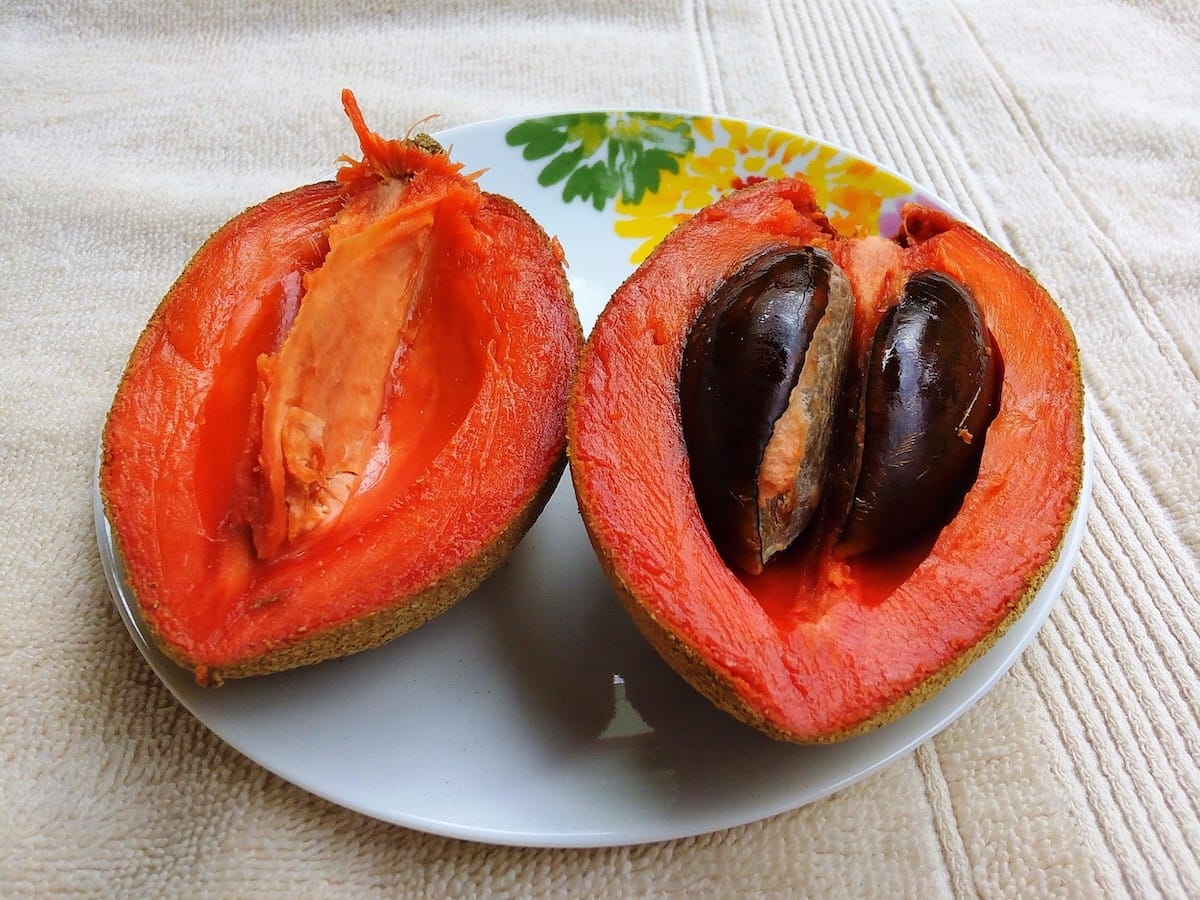
You can enjoy the sapote fruit raw or add it to a mousse, milkshake, or smoothie. In Hawaii, the sapote ripens in the spring.
Rambutan
Rambutan fruit is one of the few native Hawaiian fruits. Although similar to the lychee, the rambutan is a bit tarter and strange-looking, with its red shell covered with green “hairs.”
To eat these hairy creatures, you can bite them to crack them open or run a knife around the middle of the fruit to get to the white ball of flesh in the middle. There is a seed in the middle that you will have to spit out.
Just eat a handful of rambutans for those looking for an additional source of iron, potassium, and Vitamin C.
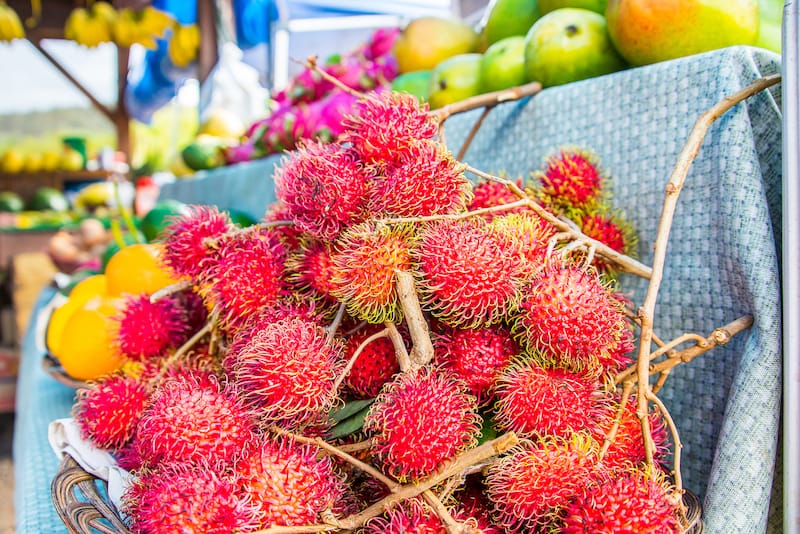
The fruit is also a great addition to fruit salads, sorbets, ice cream, or curries.
From October through March, the best place to find rambutans is at farmers’ markets across Hawaii.
Durian
Durians might not be the easiest or sweetest-smelling fruit you can eat in Hawaii, but its creamy vanilla custard-flavored center will have you enjoying it on ice cream or in cheesecake.
Even though the green, prickly durian fruit, native to Southeast Asia, has many health benefits, you must first get over the rotten onion smell it gives off.
Then you must chop through the hard, spiky shell of the two- to seven-pound, foot-long fruit.
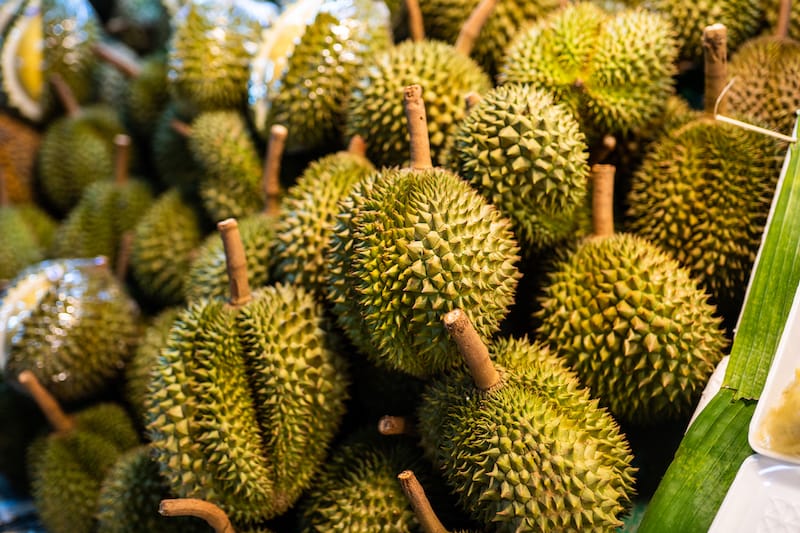
Once opened up, scoop the flesh out of each half and enjoy the fruit packed full of iron, potassium, fiber, and vitamin C. Eating durian is even known to help lower blood pressure.
If you want to try durian on your Hawaiian vacation, head to the Hakalau Farmer’s Market north of Hilo on the Big Island of Hawaii, where you can purchase fresh durian paste that you can use while cooking.
The oNo Organic Farms in Hana, Maui, offers exotic fruit adventures where you can taste a wide variety of Hawaiian fruits, including durian.
The durians are usually ripe and ready to be picked throughout the summer months (June–September).
Poha Berries
The orange poha berry is an orange berry that grows inside a husk, very similar to a husk tomato.
These small, 1-inch berries have waxy skin and grow on bushes. The tart berries are a great source of vitamin C.
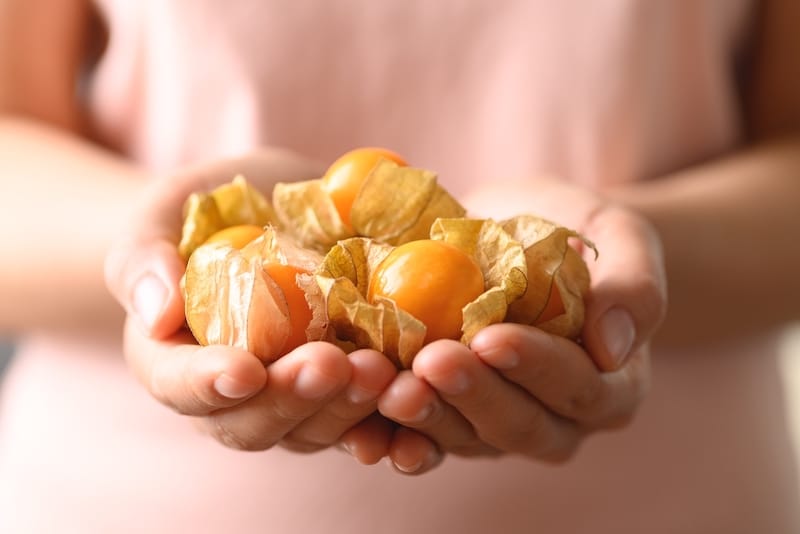
Some favorite ways to enjoy poha berries are baked goods, jam, ice cream, and salads.
When exploring Volcano National Park on the Big Island of Hawaii, stop at Akatsuka Orchid, where you can enjoy their orchids and poha berries.
Jackfruit
The jackfruit, in the fig and breadfruit family, grows on a jack tree and originated around southern India and the rainforests of Indonesia and the Philippines. It is also Bangladesh’s national fruit.
Jackfruit is an oblong fruit with bumpy green skin that can weigh more than five pounds when ripe.
When jackfruit is ripe, the yellow fruit has the texture of a banana or mango, but it has a sweet taste that may remind you of pulled pork.
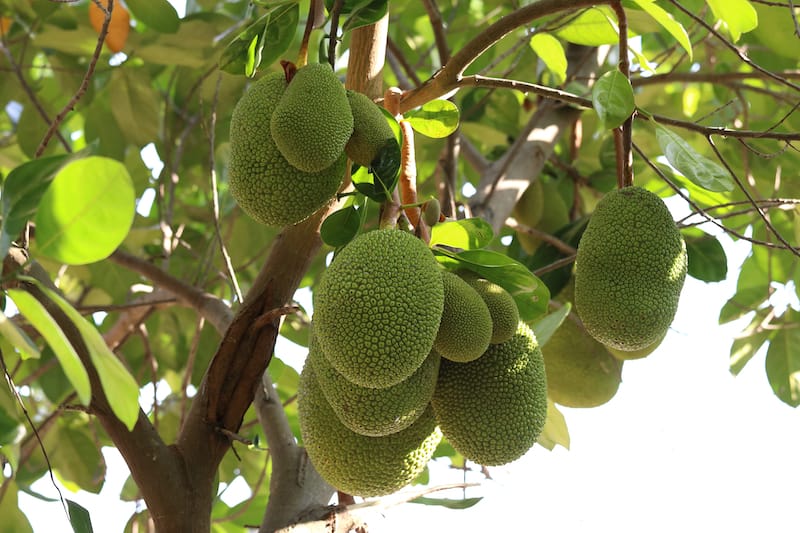
Jackfruit can be sliced and eaten raw or before it is ripe. Vegetarian dishes can be prepared with jackfruit as a meat alternative.
The seeds are high in protein and, if boiled for 20–30 minutes, are a great snack or addition to a salad.
Mountain Apples
The red pepper-shaped mountain apples are native to Australia and Malaysia and were initially brought to Hawaii by the Polynesians, so they would have wood to build their canoes and beams for their homes.
You can enjoy eating a mountain apple just like you do an apple you buy at the grocery store on the mainland, but know it will be super juicy, sweet, and smell a bit like a rose.
If you don’t want to eat the apple as a snack or part of your lunch, then cook the apple slices up and add some cinnamon, ginger, and a splash of lemon juice, and you will have a delicious applesauce to go with your dinner.
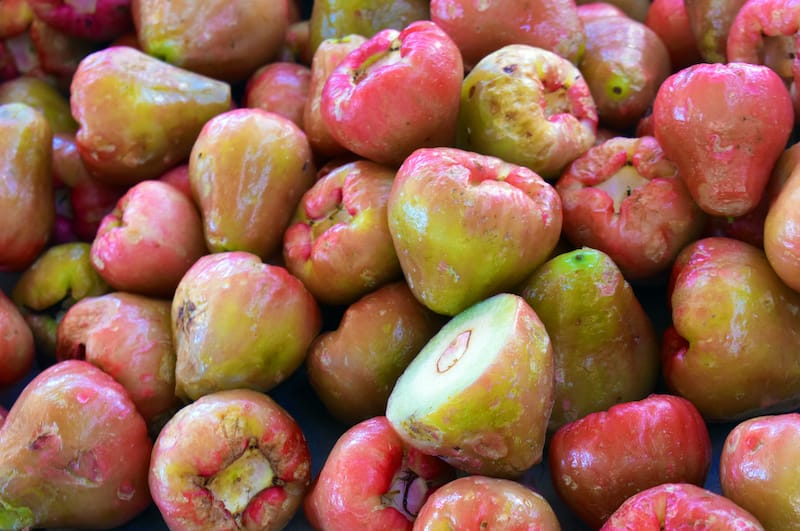
If you are visiting Oahu, enjoy exploring the Manoa Valley and take the short 1.6-mile round-trip hike to Manoa Falls.
Along the way, you will find several areas with mountain apple trees. If you are hiking in the late summer through the fall, shake a tree branch and have a friend catch a falling apple or two.
They make a great hiking snack.
Loquat (Biwa or Pipa)
The loquat fruit dates back to the 1700s, when it was grown across Europe, and it is thought that the Chinese immigrants brought it to Hawaii since they use the extract from the leaves as traditional Chinese medicine.
To eat the tiny yellow fruit, peel the skin and eat it whole, avoiding the seeds.
You can also slice the fruit and add it to rice pudding, curries, and salads since the fruit has a tart flavor and will add a little kick to anything you add.
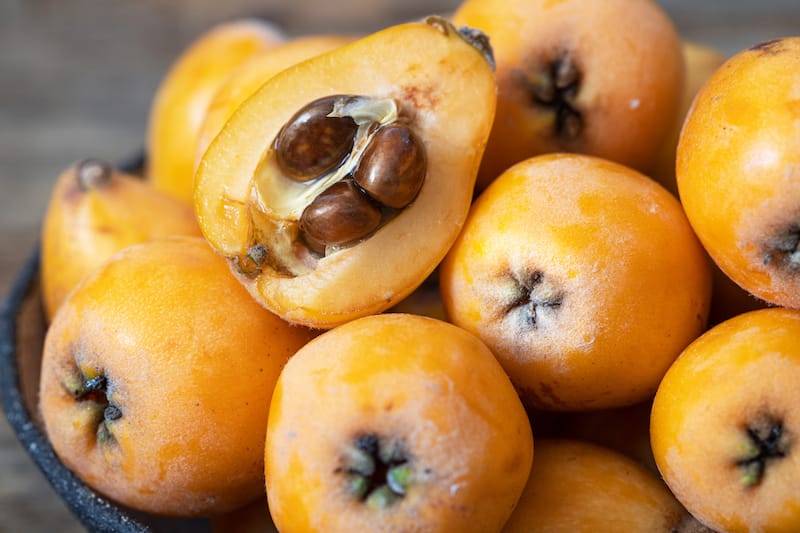
The loquats also make tasty preserves, salsas, and delicious cobblers.
If you want fresh Hawaiian loquats, you must visit one of the local farmers’ markets in March since their season is very short.
Mangosteen
The purple mangosteens, native to Southeast Asia, have juicy, white-orange-like sections inside. To eat the mangosteen, cut it in half or wedges like an orange, eat the white flesh, or add it to a salad or with vegetables.
When on the Big Island of Hawaii, head to the Hilo Farmers Market between May and August to pick up fresh mangosteen to enjoy.
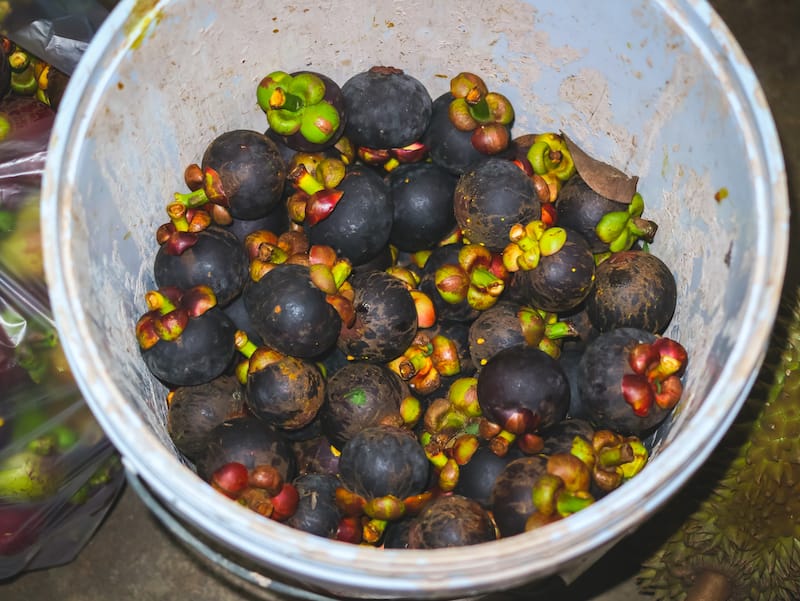
The mangosteen wedges have a tangy sweet flavor similar to a peach or mango, are low in calories, and are packed with fiber, minerals, and vitamins B and C.
Note: It is recommended that pregnant and breastfeeding women not eat mangosteen. Besides eating mangosteen, they are used in skincare products.
Starfruit (Carambola)
Native to Southeast Asia, the tart but sweet starfruit grows on trees and is a small yellow or green fruit covered with scales.
Each slice looks like a star and makes the perfect decorative garnish when you slice it. You can also eat it like an apple or add it to stir-fry, your morning juice, or sherbet.
While in Hawaii, you can purchase starfruit at grocery stores or fruit stands throughout the summer.
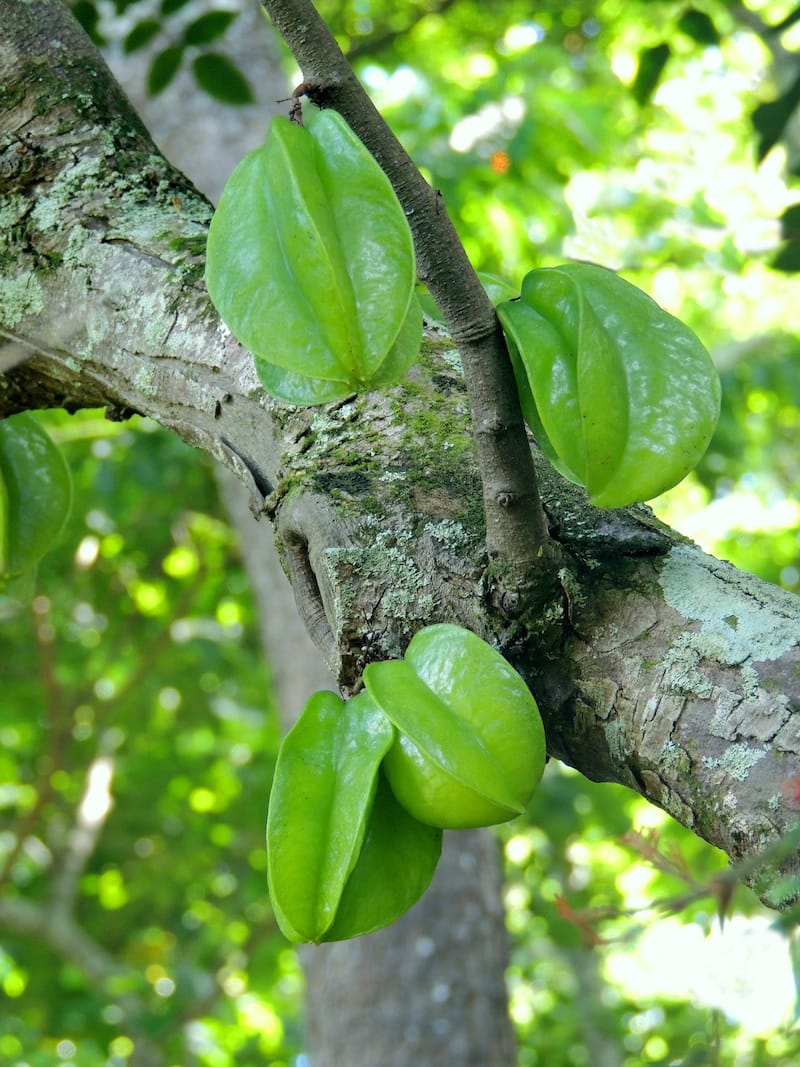
Note: Starfruit is not recommended for those with kidney disease since it contains a neurotoxin or if on heart medication since it negates the medicine.
Kamaaina Land Nursery in Haleiwa, Oahu, has an organic fruit farm and grows starfruit. They even, at times, offer tours of their farm so you can see the starfruit growing on the trees.
Surinam Cherries (Pitanga)
Unlike the Halloween orange pumpkins, Hawaii has tiny pumpkins that transition from green and orange to red and shiny, called Surinam cherries, that grow on trees instead of vines.
The Surinam cherries, native to the east coast of South America, are tasty raw when they are a very dark red or red-blue.
To eat the cherry, pop it in your mouth and enjoy the sweet-tart flavor, but don’t eat the seeds. A special treat could be vanilla ice cream topped with sliced Surinam cherries sprinkled with sugar.
The fruit is also a delicious addition to a salad or cooked up into sauces, jellies, and jams.
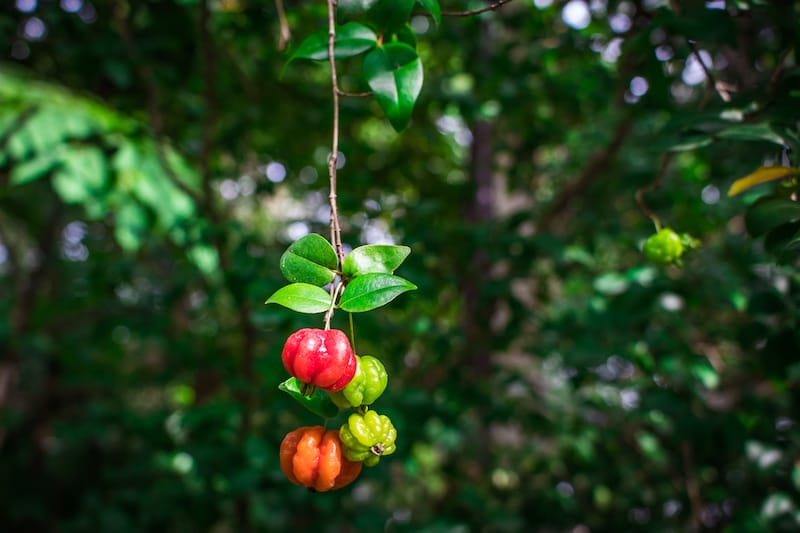
Surinam cherries contain vitamins A and C, antioxidants, and iron.
Across Central and South America, Surinam cherry tree leaves are used as an insect repellant since they give off a pungent smell.
The cherries have two seasons: the first in the spring, from April through June, and then in the fall, from October through December.
Dragon Fruit (Pitaya)
Dragon fruit, indigenous to South America and Mexico, is an oval fruit that is usually pink on the outside with green scales and grows on a cactus. On the inside, you will find white or pinkish flesh with tiny black seeds.
The dragon fruit, sometimes called a strawberry pear, can be peeled and sliced like an apple or cut in half and scooped out with a melon baller or spoon.
Eating the sweet but crunchy dragon fruit raw is best, but you can add it to desserts, smoothies, or a salad. It also pairs well when cooked with mahimahi or tuna.
The dragon fruit is fat-free, low in calories, and contains plenty of vitamin C, fiber, iron, and magnesium.
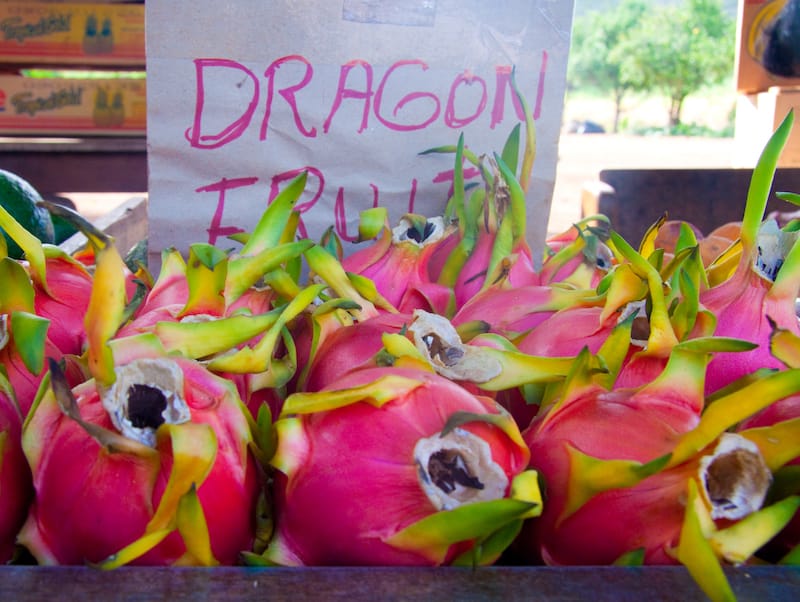
When in Oahu and looking for a great sunrise hike, take the Lanikai Pillbox Hike along the Kaiwa Ridge Trail.
You will have great views of the windward side of Oahu, and it will take you past dragon fruit cacti. You may be able to enjoy a dragon fruit snack if you are hiking between late July and October.
In West Maui, the 27-acre Maui Dragon Fruit Farm offers a chance to take a fruit-tasting talking tour.
Did we miss any amazing Hawaiian fruits to try on your trip? Let us know your favorite fruit in Hawaii in the comments. Thanks!
More Hawaii Food Guides
Pin this Fruit in Hawaii Guide
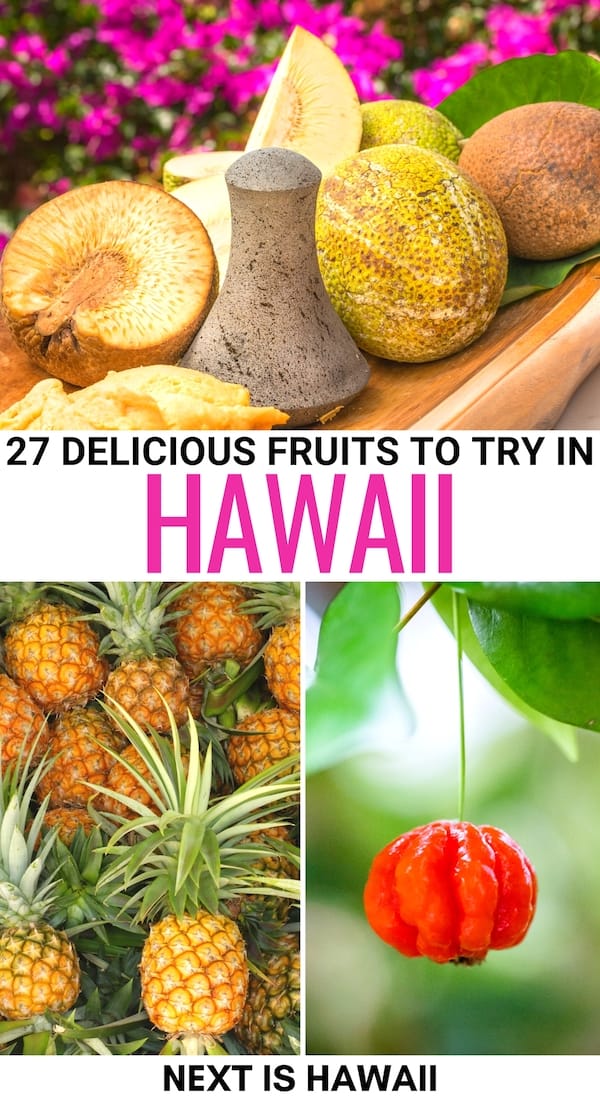

Laura Gray is a travel blogger and retired teacher. She is from Western PA but has lived in VA for the past 30+ years, with several trips to Hawaii. During the summer months, you will find her enjoying the beach in her hometown when not out on an adventure. Laura thrives on creating itineraries to make the most of each place she visits. She enjoys exploring National Parks (Laura has explored 1/3 of all the US National Parks), waterfalls, and beaches. Her travel blog posts have been featured on nearly a dozen sites.
